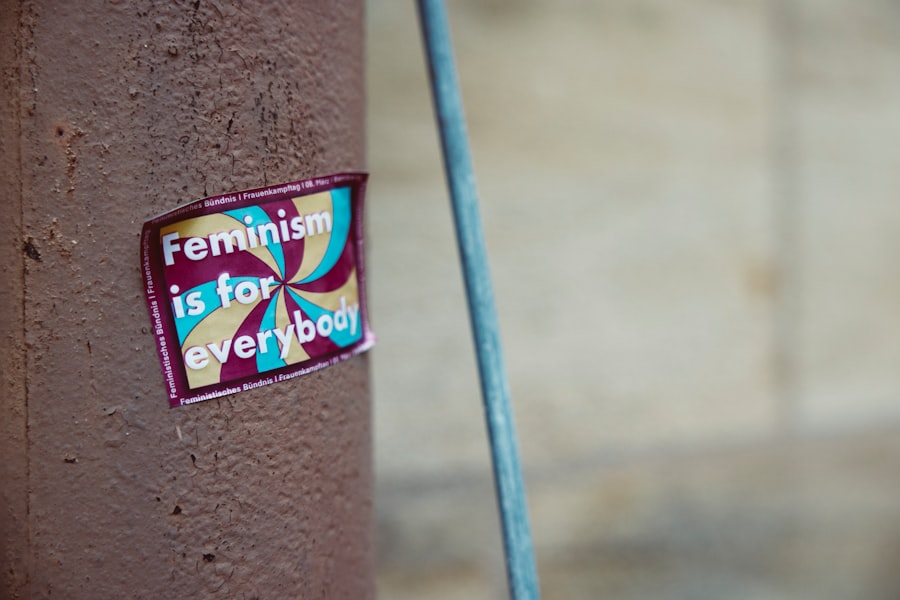Feminism, as a social and political movement, has evolved through various waves, each characterized by distinct goals and ideologies. The first wave, which emerged in the late 19th and early 20th centuries, primarily focused on legal issues and inequalities, particularly women’s suffrage. This period was marked by the efforts of pioneering figures such as Susan Anthony and Emmeline Pankhurst, who fought tirelessly for women’s right to vote.
However, the cultural dichotomy of the time often placed women in a subordinate position, relegating them to domestic roles while men occupied the public sphere. This division not only shaped the feminist discourse of the era but also highlighted the cultural norms that dictated gender roles. As feminism progressed into its second wave during the 1960s and 1970s, the focus expanded to include issues of sexuality, family, and workplace rights.
This wave was influenced by the civil rights movement and sought to address the systemic inequalities that women faced in various aspects of life. Cultural dichotomies continued to play a significant role, as traditional views on femininity and masculinity clashed with the emerging feminist ideals. The rise of consciousness-raising groups allowed women to share their experiences and challenge the cultural narratives that had long defined their identities.
This period also saw the emergence of diverse feminist voices, including those from marginalized communities, who began to critique the mainstream feminist movement for its lack of inclusivity.
Key Takeaways
- The history of feminism has been shaped by cultural dichotomies, with different cultures having varying attitudes towards gender equality.
- Cultural dichotomy has a significant impact on gender equality, with some cultures promoting gender equality while others perpetuate gender stereotypes and discrimination.
- Intersectionality plays a crucial role in understanding the relationship between feminism and culture, as it highlights how different aspects of identity intersect and impact experiences of oppression and privilege.
- Language and communication are important factors in perpetuating or challenging cultural dichotomies and promoting feminism, as they shape societal attitudes and perceptions of gender roles.
- Challenging traditional gender roles and cultural expectations is essential for promoting gender equality within cultural dichotomies, as it involves dismantling harmful stereotypes and promoting inclusivity.
The Impact of Cultural Dichotomy on Gender Equality
Cultural dichotomy refers to the division of society into contrasting cultural groups, often leading to conflicting values and beliefs. This phenomenon has profound implications for gender equality, as it shapes societal attitudes toward gender roles and expectations. In many cultures, traditional norms dictate that men are breadwinners and decision-makers, while women are caregivers and homemakers.
Such rigid classifications can hinder progress toward gender equality by perpetuating stereotypes that limit opportunities for both genders. For instance, in societies where patriarchal values dominate, women may face barriers to education and employment, reinforcing economic disparities. Moreover, cultural dichotomies can create a sense of competition between different gender identities, leading to further marginalization of those who do not conform to traditional roles.
In many cases, individuals who challenge these norms—such as transgender or non-binary people—experience discrimination and violence. The impact of cultural dichotomy on gender equality is not merely theoretical; it manifests in real-world consequences such as wage gaps, underrepresentation in leadership positions, and limited access to reproductive rights. Addressing these disparities requires a nuanced understanding of how cultural beliefs shape perceptions of gender and the systemic barriers that arise from them.
Feminism and Intersectionality: Understanding the Role of Culture

Intersectionality is a critical framework within feminism that recognizes how various social identities—such as race, class, sexuality, and ability—intersect to create unique experiences of oppression and privilege. This concept was popularized by Kimberlé Crenshaw in the late 1980s and has since become a cornerstone of contemporary feminist thought. Understanding intersectionality is essential for addressing the complexities of cultural dichotomy, as it highlights how different cultural contexts can influence women’s experiences differently.
For example, a Black woman may face discrimination not only based on her gender but also due to her race, which can compound her experiences of inequality. Cultural factors play a significant role in shaping these intersecting identities. In some cultures, traditional practices may dictate specific roles for women based on their ethnicity or socioeconomic status.
For instance, Indigenous women may encounter unique challenges related to land rights and cultural preservation that are not addressed by mainstream feminist movements. By incorporating an intersectional lens into feminist discourse, activists can better understand the diverse experiences of women across different cultural contexts and advocate for more inclusive policies that address their specific needs.
The Role of Language and Communication in Cultural Dichotomy and Feminism
Language is a powerful tool that shapes our understanding of gender and culture. The way we communicate about gender issues can either reinforce or challenge cultural dichotomies. For instance, the use of gendered language in many societies often perpetuates stereotypes about masculinity and femininity.
Terms like “man up” or “like a girl” carry implicit messages about strength and weakness that can influence societal attitudes toward gender roles. Feminist linguists have long argued for the importance of language in shaping perceptions of gender, advocating for more inclusive language that reflects diverse identities. Moreover, communication styles can vary significantly across cultures, impacting how feminist messages are received and understood.
In some cultures, direct confrontation may be seen as disrespectful, while in others, it may be necessary for effective advocacy. Understanding these nuances is crucial for feminists working within diverse cultural contexts. For example, grassroots movements in various countries have employed storytelling as a means of raising awareness about gender issues, allowing individuals to share their experiences in culturally resonant ways.
By adapting communication strategies to align with cultural norms, feminists can foster greater understanding and solidarity across different communities.
Challenging Traditional Gender Roles and Cultural Expectations
Challenging traditional gender roles requires a multifaceted approach that addresses both individual attitudes and systemic structures. In many cultures, deeply ingrained beliefs about masculinity and femininity dictate how individuals are expected to behave. For instance, men may be socialized to suppress emotions and prioritize aggression or dominance, while women may be encouraged to prioritize nurturing and submissiveness.
These expectations can limit personal freedom and contribute to toxic behaviors that harm both genders. Activism aimed at redefining these roles often involves education and awareness-raising initiatives that encourage critical reflection on societal norms. Programs that promote positive masculinity challenge men to embrace vulnerability and emotional expression while advocating for women’s rights.
Similarly, initiatives aimed at empowering women—such as leadership training or mentorship programs—can help dismantle the barriers created by traditional expectations. By fostering environments where individuals can explore their identities beyond rigid gender norms, societies can move toward greater equality.
Strategies for Promoting Gender Equality within Cultural Dichotomies

Promoting gender equality within cultural dichotomies necessitates a strategic approach that considers the unique challenges posed by differing cultural contexts. One effective strategy is to engage local communities in discussions about gender roles and expectations. By facilitating dialogues that include diverse voices—particularly those from marginalized groups—activists can create spaces for shared understanding and collective action.
Another important strategy involves leveraging technology and social media to amplify feminist voices across cultural boundaries. Digital platforms provide opportunities for grassroots movements to connect with global audiences, share stories, and mobilize support for gender equality initiatives.
Campaigns that utilize hashtags or viral challenges can raise awareness about specific issues while fostering solidarity among individuals from different backgrounds. Additionally, partnerships with local organizations can enhance the effectiveness of these campaigns by ensuring they are culturally relevant and resonate with target audiences. In conclusion, addressing gender equality within cultural dichotomies requires a comprehensive understanding of historical contexts, intersectional identities, language dynamics, traditional roles, and strategic activism.
By recognizing the complexities inherent in these issues, feminists can work toward creating more equitable societies that honor diverse experiences and promote inclusivity across all cultural landscapes.
An interesting related article is Top Business Schools in the World and India and Career Prospects for Management Graduates. This article delves into the gender disparities within the realm of business education and career advancement, highlighting how cultural and institutional frameworks can impact women’s opportunities and representation in leadership roles. By examining these intersections, we can gain a deeper understanding of the challenges and progress within the feminist movement.
FAQs
What is feminism?
Feminism is a social and political movement that advocates for the rights and equality of women in various aspects of society, including politics, economics, and culture.
What is cultural dichotomy?
Cultural dichotomy refers to the division or contrast between two different cultural perspectives or values within a society.
How does feminism intersect with cultural dichotomy?
Feminism intersects with cultural dichotomy by addressing the unequal treatment and representation of women within different cultural contexts, and by challenging traditional gender roles and stereotypes.
What is the gender perspective in the context of feminism and cultural dichotomy?
The gender perspective in the context of feminism and cultural dichotomy involves analyzing how cultural norms and values impact the experiences and opportunities of individuals based on their gender, and advocating for gender equality and inclusivity.























+ There are no comments
Add yours